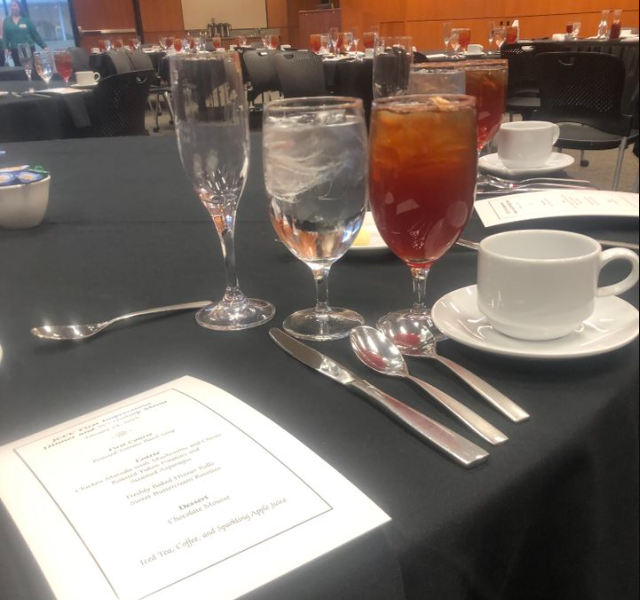By Tabitha Burt
Recently, I had the opportunity to attend the First Impressions Networking and Etiquette dinner, hosted by Mary Jean Billingsley of The Protocol School of Washington. About 20 other guests and I enjoyed good company, excellent food, and even better insights from Billingsley’s expertise. Billingsley has done etiquette talks for the past twenty-five years, and used to head the Career Development Center at JCCC. She told me that etiquette has changed a lot over the years, so I was excited to learn what those changes were.
Throughout the course of your life, you may have occasion to be interviewed over dinner. You may already know the ins and outs of interview best practices, but the meal adds a whole new dimension to what’s expected of you. Billingsley keeps our focus simple: “What really matters is doing things that make those around you feel comfortable,” she said, as well as welcome, respected, appreciated, and remembered. All etiquette rules she went over that night were in service of those values.
From the most elegant way to pull out a chair, to the proper way to scoop your mousse, Billingsley taught us the unwritten rules of a social gathering, as well as the practicalities of dining manners. Scooping your tomato bisque away from you prevents embarrassing spills. “BMW” is a handy acronym to remember that your “bread, meal, and water/wine” go left to right so you can easily tell what dishes belong to you. While there are several right and wrong ways to eat your food, the most important thing to remember is to not call attention to yourself: the business at hand is more important than the food.
Two interesting things that have changed since I was taught dinner manners as a child have to do with cutting your meat, and hand placement. It used to be that you were only supposed to cut one bite of meat at a time, then swap hands with your fork to eat it. Now, in today’s busy world, Billingsley told us it was appropriate to cut up to three bites of our chicken marsala with asparagus and potatoes. Having your non-dominant hand in your lap when not using it used to be the norm. Today, with phones so prevalent, it’s polite to rest your wrist on the table so everyone knows you’re not on your phone under it (as I was, taking notes). As Billingsley puts it, “When setting a table, there is no place for a mobile phone.”
A highlight of the evening was Billingsley teaching us proper toasting manners with sparkling apple juice. “Be sincere, be kind, be seated,” she claimed, were the only guidelines for the toaster, but if a specific person was being toasted, they should not drink as it would be like clapping for themselves.
Overall, I had a lovely time at the First Impressions Etiquette dinner. There will be another in October of this year, and I hope to see you all there. Finally, if you ever have occasion to attend an interview over a meal, Billingsley says the best way to make a good last impression is to send a handwritten thank you note.












Leave a Reply